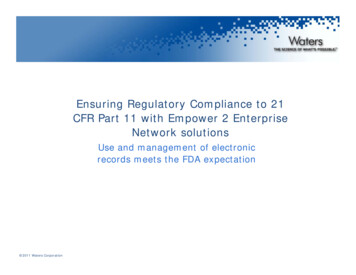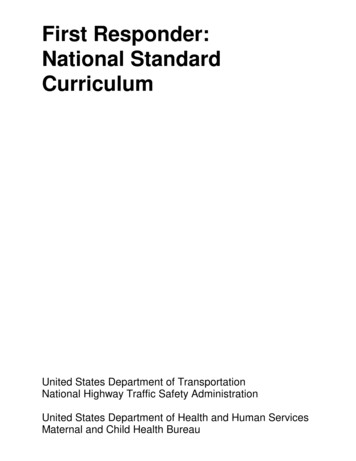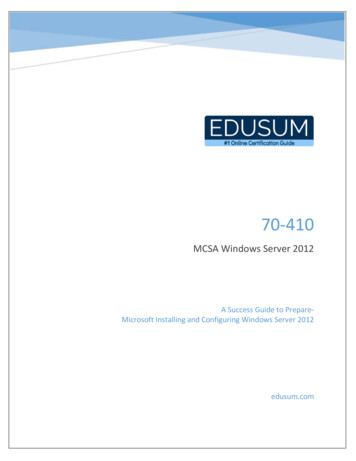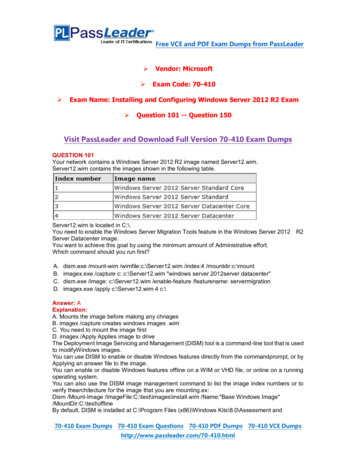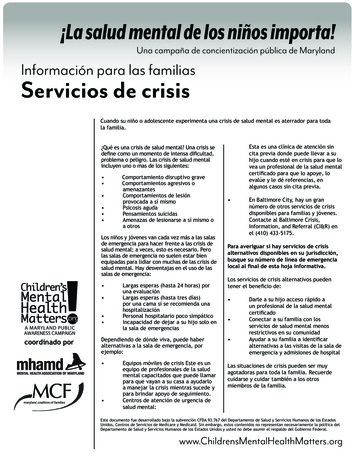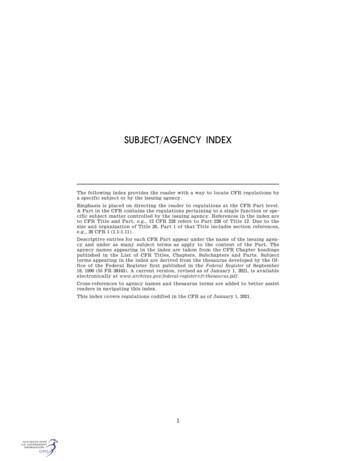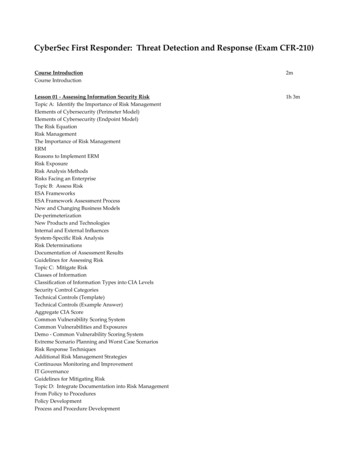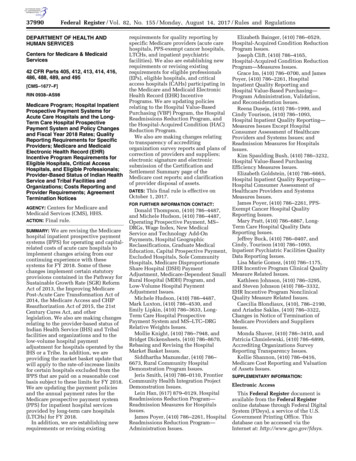
Transcription
CyberSec First Responder (CFR-410) Exam BlueprintDate Issued: 5/1/2021Date Modified: 2/22/2022Version: 1.10Approved by: Scheme Committee
Introduction to CertNexusCertNexus is a vendor-neutral certification body, providing emerging technology certifications andmicro-credentials for business, data, developer, IT, and security professionals. CertNexus’ mission isto assist closing the emerging tech global skills gap while providing individuals with a path towardsrewarding careers in Cybersecurity, Data Science, Internet of Things, and Artificial Intelligence (AI)/Machine Learning.CertNexus develops its high-stakes exams following the American National Accreditation Board(ANAB) standard for certification development (ISO IEC 17024). CFR is accredited by ANAB under theISO 17024 standard. This standard is a very rigorous, controlled process for initiating, developing,and maintaining our certification programs. We rely on our Subject Matters Experts (SMEs) to providetheir industry expertise and help us develop these certifications by participating in a Job TaskAnalysis, Exam Item Development, and determining the Cut Score. We also depend upon practitioners in the field to participate in a survey of the Job Task Analysis and beta testing to ensure thatour certifications validate knowledge and skills relevant to the industry.AcknowledgementsCertNexus was honored to have the following subject matter experts contribute to the developmentof this exam blueprint.Dr. Erdal OzkayaComodo CybersecurityTyler SnyderUSAF, AFCERThttps://www.comodo.com/Ashley PearsonWilliam Smith Jrblog.onfvp.comJohns Hopkins Applied Physics LaboratoryPredrag ski.comVanshika GuptaLeyla AliyevaProton Technologies Inc.www.protontechs.comŞükrü DurmazDIFOSE Digital Forensic Services LLCwww.difose.comDallas BishoffMANUS360https://manus360.com/Aaron SandersPaychexhttps://www.paychex.com/Kekai NamauuDynamic Advancementwww.dynamicadvancement.comBen OttomanAvaushttps://www.avaus.com/Paul JanesFiservhttps://www.fiserv.com/Paul DumbletonGordon Food Servicehttps://www.gfs.com/en-usBrian CopelandKBR, Inc.https://www.kbr.com/enAdam DanielukISSA Polskahttps://www.issa.org.pl/Petr McAllisterTetratehttps://www.tetrate.io/Copyright 2022 by CertNexus Inc. All rights reserved.CertNexus CyberSec First Responder (CFR-410)Exam Objectives are subject to change without notice.CertNexus CyberSec First Responder (CFR-410) Exam Blueprint
Alignment with U.S. Department of Defense Directive 8570.01-MCFR-410 is designed primarily for cybersecurity practitioners preparing for, or who currently perform,job functions related to protecting information systems by ensuring their availability, integrity,authentication, confidentiality, and non-repudiation. It is ideal for those roles within federalcontracting companies and private sector firms whose mission or strategic objectives require theexecution of Defensive Cyber Operations (DCO) or DoD Information Network (DoDIN) operation andincident handling and are seeking personnel to be in compliance with CMMC Incident Response (IR),Audit and Accountability (AU), and Risk Management (RM) domains.This certification (CFR-410) meets all requirements for personnel requiring DoD directive 8570.01-Mposition certification baselines: CSSP Analyst CSSP Infrastructure Support CSSP Incident Responder CSSP AuditorCyberSec First Responder (CFR) Exam CFR-410Exam InformationA CyberSec First Responder is an IT professional with demonstrated expertise in networking,operating systems, application security, or cloud environments, and their role is to identify, protect,detect, respond, and recover from cybersecurity incidents for their organizations. They have theadvanced knowledge, skills, and abilities to deal with an evolving and constantly changing threatlandscape, zero-day exploits, and can identify and implement cybersecurity best practices, developprocesses for continuous monitoring and detection of potential anomalies, collect and analyzedata, accurately report results, are experienced with SIEM and SOAR, and act quickly to mitigate orremediate cyber threats. CyberSec First Responders play a critical role in securing their organization’sinformation, business processes, and intellectual property.Candidate EligibilityThe CyberSec First Responder (CFR) exam requires no application fee, supporting documentation,or other eligibility verification measures for you to be eligible to take the exam. An exam voucher willcome with your training program or can be purchased separately here. Once purchased, you willreceive more information about how to register for and schedule your exam through Pearson VUE.You can also purchase a voucher directly through Pearson VUE. Once you have obtained your voucherinformation, you can register for an exam time here. By registering, you agree to our CandidateAgreement included here.Exam PrerequisitesWhile there are no formal prerequisites to register for and schedule an exam, we strongly recommendyou first possess the knowledge, skills, and abilities to do the following: Understand the National Institute of Standard and Technology’s (NIST) CybersecurityFramework.Copyright 2022 by CertNexus Inc. All rights reserved.CertNexus CyberSec First Responder (CFR-410)Exam Objectives are subject to change without notice.CertNexus CyberSec First Responder (CFR-410) Exam Blueprint
Identify applicable compliance, standards, frameworks, and best practices for privacy andsecurity.Understand the cybersecurity threat landscape.Assess cybersecurity risk in computing environments within a risk management framework.Evaluate an organization’s cybersecurity posture.Conduct vulnerability assessment processes and identify common areas of vulnerability.Perform analysis of network assets.Utilize log sources for continuous monitoring and detection of potential anomalies.Analyze attacks and post-attack techniques on computing environments.Assess and apply organizational cybersecurity policies and procedures.Communicate with other stakeholder groups to coordinate incident response processes.Prepare for and execute incident response processes when an incident has occurred.Implement recovery planning processes and procedures to restore systems and assetsaffected by cybersecurity incidents.You can obtain this level of skill and knowledge by taking the following courseware, which isavailable through training providers around the world, or by attending an equivalent third-partytraining program: CertNexus CyberSec First Responder (Exam CFR-410)Exam SpecificationsNumber of Items: 80Passing Score: 70% or 73% depending on exam form. Forms have been statistically equated.Duration: 120 minutes (Note: exam time includes 5 minutes for reading and signing the CandidateAgreement and 5 minutes for the Pearson VUE testing system tutorial.)Exam Options: In person at Pearson VUE test centers or online via Pearson OnVUEItem Formats: Multiple Choice/Multiple ResponseExam DescriptionTarget Candidate:The CyberSec First Responder (CFR) exam is designed for individuals with between 2 and 5 years ofexperience working in a computing environment as part of a CERT, CSIRT, SOC, Command andcontrol (C2) systems, or as an IT professional on the front line of cybersecurity at their organizations,who desire or are required to protect critical information systems before, during, and after anincident which may be a cybersecurity attack.Exam Objective Statement:The exam will certify that the successful candidate has the knowledge, skills, and abilities required toeffectively identify, detect, protect, respond, and recover from malicious activities involvingcomputing systems. Additionally, the candidate has the foundational knowledge to deal with achanging threat landscape and will be able to assess risk and vulnerabilities, acquire data, performanalysis, continuously communicate, determine scope, recommend remediation actions, andaccurately report results.Copyright 2022 by CertNexus Inc. All rights reserved.CertNexus CyberSec First Responder (CFR-410)Exam Objectives are subject to change without notice.CertNexus CyberSec First Responder (CFR-410) Exam Blueprint
To ensure exam candidates possess the aforementioned knowledge, skills, and abilities, theCyberSec First Responder (CFR) exam will test them on the following domains with the followingweightings:Domain1.0 Identify2.0 Protect3.0 Detect4.0 Respond5.0 RecoverTotal% of Examination22%24%18%19%17%100%The information that follows is meant to help you prepare for your certification exam. Thisinformation does not represent an exhaustive list of all the concepts and skills that you maybe tested on during your exam. The exam domains, identified previously and included in theobjectives listing, represent the large content areas covered in the exam. The objectives withinthose domains represent the specific tasks associated with the job role(s) being tested. Theinformation beyond the domains and objectives is meant to provide examples of the types ofconcepts, tools, skills, and abilities that relate to the corresponding domains and objectives.All of this information represents the industry-expert analysis of the job role(s) related to thecertification and does not necessarily correlate one-to-one with the content covered in yourtraining program or on your exam. We strongly recommend that you independently study tofamiliarize yourself with any concept identified here that was not explicitly covered in yourtraining program or products.ObjectivesDomain 1.0Objective 1.1IdentifyIdentify assets (applications, workstations, servers, appliances, operatingsystems, and others). Asset identification tools Active Passive Tools Nessus Nmap Network monitoring tools Operating system information macOS Windows Linux/Unix Android iOS Determine which tools to use for each part of the networkCopyright 2022 by CertNexus Inc. All rights reserved.CertNexus CyberSec First Responder (CFR-410)Exam Objectives are subject to change without notice.CertNexus CyberSec First Responder (CFR-410) Exam Blueprint
Objective 1.2Objective 1.3Objective 1.4 Network topology and architecture information Data flow Vulnerable ports SPAN ports and TAP devices for live packet captureIdentify factors that affect the tasking, collection, processing, exploitation,and dissemination architecture’s form and function. Identify relevant policies and procedures Collect artifacts and evidence based on volatility level Review service level agreements (SLAs) Network scanning Assets and underlying risks Data collection Data analytics and e-discovery Monitor threats and vulnerabilities CVSS CVE CWE CAPEC Threat modeling Identify TTPsIdentify and evaluate vulnerabilities and threat actors. Vulnerability scanning tools Threat targets Individuals Non-profit associations Corporations Governments Critical Infrastructure Systems Mobile IoT SCADA ICS PLC Threat actors Threat motives/reasons Threat intent Attack phases Attack vectors Technique criteriaIdentify applicable compliance, standards, frameworks, and best practicesfor privacy. Privacy laws, standards, and regulations GDPR HIPAA COPPACopyright 2022 by CertNexus Inc. All rights reserved.CertNexus CyberSec First Responder (CFR-410)Exam Objectives are subject to change without notice.CertNexus CyberSec First Responder (CFR-410) Exam Blueprint
Objective 1.5Objective 1.6 GLBA CAN-SPAM National privacy laws Frameworks NIST Privacy Framework ISO/IEC 27000 series ISO 29100 AICPA Generally Accepted Privacy Principles (GAPP) Best practices Federal Trade CommissionIdentify applicable compliance, standards, frameworks, and best practicesfor security. Security laws, standards, and regulations ISO/IEC 27000 series ANSI/ISA-62443 NIST Special Publication 800 Series Standard of Good Practice from ISF NERC 1300 RFC 2196 PCI DSS SSAE 18 Frameworks NIST Cybersecurity Framework CIS Critical Security Controls COBIT NIST Special Publication 800-61 DoD Risk Management Framework (RMF) IT Assurance Framework (ITAF) Best practices OWASP MITRE CAPEC CSAIdentify and conduct vulnerability assessment processes. Critical assets and data Establish scope Determine vulnerability assessment frequency Identify common areas of vulnerability Users Internal acceptable use policies Operating systems Applications Networking software Network operations and management Firewall Network security applicationsCopyright 2022 by CertNexus Inc. All rights reserved.CertNexus CyberSec First Responder (CFR-410)Exam Objectives are subject to change without notice.CertNexus CyberSec First Responder (CFR-410) Exam Blueprint
Objective 1.7Domain 2.0Objective 2.1 Database software Network devices Access points Routers Wireless routers Switches Firewall Modems NAT (Network Address Translation) Network infrastructure Network configurations Network services DSL Wireless protocols IP addressing Configuration files IoT Regulatory requirements Changes to the system Determine scanning criteria IoC information Perform a vulnerability assessment Determine scanning criteria Utilize scanning tools Identify and assess exposures Generate reports Conduct post-assessment tasks Remediate/mitigate vulnerabilities Recovery planning processes and procedures Hardening Patches Exceptions documented Conduct audit/validate action was takenEstablish relationships between internal teams and external groups likelaw enforcement agencies and vendors. Formal policies that drive these internal and external relationships andengagements SLAs Communication policies and procedures Points of contact and methods of contact Vendor agreements, NDAs, and vendor assessment questionnaires Privacy rules and laws Understanding of relevant law enforcement agenciesProtectAnalyze and report system security posture trends. Data analyticsCopyright 2022 by CertNexus Inc. All rights reserved.CertNexus CyberSec First Responder (CFR-410)Exam Objectives are subject to change without notice.CertNexus CyberSec First Responder (CFR-410) Exam Blueprint
Objective 2.2Objective 2.3Prioritize the risk observations and formulate remediation stepsAnalyze security system logs, tools, and dataThreats and vulnerabilitiesIntrusion prevention systems and toolsSecurity vulnerability databases CVE CVSS OSVDB Discover vulnerabilities in information systems Create reports and document evidenceApply security policies to meet the system’s cybersecurity objectives anddefend against cyber attacks and intrusions. Cybersecurity policies and procedures Acceptable use policy Network access control (NAC) Disaster recovery and business continuity plans Remote work policies Active Directory Group Policy Objects (GPOs) Best practices in hardening techniques Threats and vulnerabilities Security laws, standards, and regulations Risk management principles Attack methods and techniques Footprinting Scanning Enumeration Gaining access Web attacks Password attacks Wireless attacks Social engineering Man-in-the-middle Malware Out of band DoS DDoS Resource exhaustion Forced system outage Packet generatorsCollaborate across internal and external organizational lines to enhancethe collection, analysis, and dissemination of information. Organizational structure Internal teams Personnel roles and responsibilities Communication policies and procedures Knowledge sharing processesCopyright 2022 by CertNexus Inc. All rights reserved.CertNexus CyberSec First Responder (CFR-410)Exam Objectives are subject to change without notice.CertNexus CyberSec First Responder (CFR-410) Exam Blueprint
Objective 2.4Objective 2.5Objective 2.6Objective 2.7 Conflict management SLAs Relationships with external stakeholders Law enforcement VendorsEmploy approved defense-in-depth principles and practices. Intrusion Prevention or Detection Systems (IDS/IPS) Firewalls Network Segmentation Endpoint Detection and Response (EDR) Account Management The Principle of Least Privilege Separation of duties Password policy enforcement Active directory hygiene Patch management Mobile Device Management (MDM)Develop and implement cybersecurity independent audit processes. Identify assets Cybersecurity policies and procedures Data security policies Cybersecurity auditing processes and procedures Audit objectives Network structure Compliance standards Document and communicate resultsEnsure that plans of action are in place for vulnerabilities identified duringrisk assessments, audits, and inspections. Review assessments, audits, and inspections Analyze critical issues for action Develop plans of action Specify success criteria Remediation planning Resource implications Monitoring proceduresProtect organizational resources through security updates. Cybersecurity policies and procedures Software updates Scope Attributes Vulnerabilities Firmware updates Scope Attributes Vulnerabilities Software patchesCopyright 2022 by CertNexus Inc. All rights reserved.CertNexus CyberSec First Responder (CFR-410)Exam Objectives are subject to change without notice.CertNexus CyberSec First Responder (CFR-410) Exam Blueprint
Objective 2.8Domain 3.0Objective 3.1Protect identity management and access control within the organization,including physical and remote access. Enterprise resources Access control Authentication systems Remote-access monitoring Cybersecurity policies and procedures Identity management Authorization Infrastructure/physical security Physical security controls User credentialsDetectAnalyze common indicators of potential compromise, anomalies, andpatterns. Analyze security system logs, security tools, and data IP networking/ IP resolving DoS attacks/ DDoS attacks Security Vulnerability Databases Intrusion Detection Systems Network encryption SSL decryption SIEM Firewalls DLP IPS IDS Evaluate and interpret metadata Malware Network topology Anomalies False positives Superhuman logins/geo-velocity APT activity Botnets Unauthorized programs in the startup menu Malicious software Presence of attack tools Registry entries Unusual network traffic Bandwidth usage Malicious network communication Off-hours usage New administrator/user accounts Guest account usageCopyright 2022 by CertNexus Inc. All rights reserved.CertNexus CyberSec First Responder (CFR-410)Exam Objectives are subject to change without notice.CertNexus CyberSec First Responder (CFR-410) Exam Blueprint
Objective 3.2Unknown open portsUnknown use of protocolsService disruptionWebsite defacementUnauthorized changes/modifications Suspicious files Patches Recipient of suspicious emails Unauthorized sessions Failed logins Rogue hardwarePerform analysis of log files from various sources to identify possiblethreats to network security. Log collection Agent-based Agentless Syslog Log auditing Source validation Verification of log integrity Evidence collection Log enrichment IP address and hostname resolution Field name consistency Time zones Alerts, reports, and event correlation Threat hunting Long tail analysis Intrusion detection Behavioral monitoring Log retention Industry compliance/regulatory requirements Log aggregator and analytics tools SIEM Linux tools grep cut diff Windows tools Find WMIC Event Viewer Scripting languages Bash PowerShellCopyright 2022 by CertNexus Inc. All rights reserved.CertNexus CyberSec First Responder (CFR-410)Exam Objectives are subject to change without notice.CertNexus CyberSec First Responder (CFR-410) Exam Blueprint
Objective 3.3Objective 3.4 Data sources Network-based WAP logs WIPS logs Controller logs Packet capture Traffic log Flow data Device state data SDN Host-based Linux syslog Application logs Cloud Audit logs Threat feedsProvide timely detection, identification, and alerting of possible attacks/intrusions, anomalous activities, and misuse activities and distinguishthese incidents and events from benign activities. Asset discovery methods and tools Alerting systems Intrusion Prevention or Detection Systems (IDS/IPS) Firewalls Endpoint Detection and Response (EDR) Common indicators of potential compromise, anomalies, and patterns Analysis tools Document and communicate resultsTake appropriate action to document and escalate incidents that may causean ongoing and immediate impact on the environment. Communication and documentation policies and processes Security incident reports Description Potential impact Sensitivity of information Logs Escalation processes and procedures Specific technical processes Techniques Checklists Forms Incident response teams Levels of Authority Personnel roles and responsibilities Document and communicate resultsCopyright 2022 by CertNexus Inc. All rights reserved.CertNexus CyberSec First Responder (CFR-410)Exam Objectives are subject to change without notice.CertNexus CyberSec First Responder (CFR-410) Exam Blueprint
Objective 3.5Domain 4.0Objective 4.1Determine the extent of threats and recommend courses of action orcountermeasures to mitigate risks. Post exploitation tools and tactics Command and control Data exfiltration Pivoting Lateral movement Persistence/maintaining access Keylogging Anti-forensics Covering tracks Prioritization or severity ratings of incidents Communication policies and procedures Levels of Authority Communicate recommended courses of action and countermeasuresRespondExecute the incident response process. Incident response plans and processes Communication with internal and external stakeholders Personnel roles and responsibilities Incident reporting Containment Methods Allowlist/blocklist IDS/IPS rules configuration Network segmentation Web content filtering Port blocking Containment Tools Firewall IDS/IPS Web proxy Anti-malware Endpoint security solutions DLP Windows tools to analyze incidents Registry Network File system Malware Processes Services Volatile memory Active Directory tools Linux-based tools to analyze incidents NetworkCopyright 2022 by CertNexus Inc. All rights reserved.CertNexus CyberSec First Responder (CFR-410)Exam Objectives are subject to change without notice.CertNexus CyberSec First Responder (CFR-410) Exam Blueprint
Objective 4.2Objective 4.3Objective 4.4 File system Malware Processes Volatile memory Session managementCollect and seize documentary or physical evidence and create aforensically sound duplicate that ensures the original evidence is notunintentionally modified to use for data recovery and analysis processes. Evidence collection, preservation, and security Digital Physical Chain of custody Forensic investigation Static analysis Dynamic analysis Forensic collection and analysis tools FTK EnCase eDiscovery Forensic Explorer Kali Linux Forensic Mode CAINE SANS SIFT Volatility Binalyze AIR Forensically sound duplicates Document and communicate resultsCorrelate incident data and create reports. Logs Data analysis Intrusion Prevention or Detection Systems (IDS/IPS) Forensics analysis Correlation analysis Event correlation tools and techniques Root cause analysis Alerting systems Incident reports Document and communicate resultsImplement system security measures in accordance with establishedprocedures. Escalation procedures Chain of command Organizational systems and processes Policies ProceduresCopyright 2022 by CertNexus Inc. All rights reserved.CertNexus CyberSec First Responder (CFR-410)Exam Objectives are subject to change without notice.CertNexus CyberSec First Responder (CFR-410) Exam Blueprint
Objective 4.5Objective 4.6Domain 5.0Objective 5.1Objective 5.2 Incident response plan Security configuration controls Baseline configurations Hardening documentation Document measures implementedDetermine tactics, techniques, and procedures (TTPs) of intrusion sets. Threat actors Patterns of activity Methods Tactics Early stages of the campaign Key facts of the infrastructure Artifacts and tools used Techniques Technological Non-technological ProceduresInterface with internal teams and external organizations to ensureappropriate and accurate dissemination of incident information. Communication policies and procedures Internal communication methods Secure channels Out-of-band communications External communication guidelines Local law enforcement Stockholders Breach victims Media Other CERTs/CSIRTs VendorsRecoverImplement recovery planning processes and procedures to restore systemsand assets affected by cybersecurity incidents. Post-incident Root cause analysis After Action Report (AAR) Lessons learned Reporting and documentation Analyze incident reports Execute recovery planning processes and procedures Document and communicate resultsImplement specific cybersecurity countermeasures for systems andapplications. Security requirements of systemsCopyright 2022 by CertNexus Inc. All rights reserved.CertNexus CyberSec First Responder (CFR-410)Exam Objectives are subject to change without notice.CertNexus CyberSec First Responder (CFR-410) Exam Blueprint
Objective 5.3Objective 5.4 System interoperability and integration Prevention & mitigation Actions Processes Tools and technologies Devices Systems Safeguards Security features Management constraints Personnel security Physical structures, areas, and devicesReview forensic images and other data sources for recovery of potentiallyrelevant information. Memory forensics analysis/tools Volatility Data sources and disk images Analysis of digital evidence Hardware and software tools File copying techniques Logical backup Bit stream imaging File modification, access, and creation times Forensic recordkeeping Automated audit trails Chain of custody Forensic investigation Forensic collection and analysis toolsProvide advice and input for disaster recovery, contingency, and continuityof operations plans. Recovery planning processes Contingency planning Systems and assets Lessons learned Review of existing strategies Implement improvements Document and communicate reports, lessons learned, and advice forrecovery, contingency, and continuity of operations plansCopyright 2022 by CertNexus Inc. All rights reserved.CertNexus CyberSec First Responder (CFR-410)Exam Objectives are subject to change without notice.CertNexus CyberSec First Responder (CFR-410) Exam Blueprint
Recertification RequirementsThe CyberSec First Responder (CFR) certification is valid for 3 years from the date that it is initiallygranted. In order to maintain a continuously valid certification, candidates can recertify via one ofthe following options:1. Retake the most recent version of the exam before their certification expires.2. Earn and submit enough continuing education credits (CECs) to recertify without retaking theexam.CyberSec First Responder (CFR) ded FormAfter Action ReportAmerican Institute of Certified Public AccountantsAmerican National Standards InstituteAdvanced Persistent ThreatCommand And ControlComputer Aided Investigative EnvironmentControlling The Assault of Non-Solicited Pornography And Marketing Act of 2003Common Attack Pattern Enumeration And ClassificationComputer Emergency Response TeamControl Objectives For Information And Related TechnologiesChildren’s Online Privacy Protection RuleCloud Security AllianceComputer Security Incident Response TeamCommon Vulnerabilities And ExposuresCommon Vulnerability Scoring SystemCommon Weakness EnumerationDistributed Denial of ServiceData Loss PreventionU.S. Department of DefenseDenial of ServiceDigital Subscriber LineEndpoint Detection And ResponseForensic ToolkitGenerally Accepted Privacy PrinciplesGeneral Data Protection RegulationGramm-Leach-Bliley ActGroup Policy ObjectsHealth Insurance Portability And Accountability ActIndustrial Control SystemsIntrusion Detection SystemsInternational Electrotechnical CommissionIndicator of CompromiseInternet of ThingsInternet ProtocolIntrusion Prevention SystemCopyright 2022 by CertNexus Inc. All rights reserved.CertNexus CyberSec First Responder (CFR-410)Exam Objectives are subject to change without notice.CertNexus CyberSec First Responder (CFR-410) Exam Blueprint
ISAISOITITAFMDMNATNDANERCNISTOSVDBOWASPPCI DSSPLCRFC 2196SCADASDNSIEMSLAsSOCSPANSSAE 18SSLTAPTTPsWAPWIPSWMICInternational Society For AutomationInternational Organization For StandardizationInformation TechnologyIt Assurance FrameworkMobile Device ManagementNetwork Address TranslationNon-Disclosure AgreementNorth American Electric Reliability CorporationNational Institute of Standard And TechnologyOpen Sourced Vulnerability DatabaseOpen Web Application Security ProjectPayment Card Industry Data Security StandardProgrammable Logic ControllerSite Security HandbookSupervisory Control And Data AcquisitionSoftware-Defined NetworkingSecurity Information Event ManagementService Level AgreementsSecurity Operations CenterSwitch Port AnalyzerStatement On Standards For Attestation EngagementsSecure Sockets LayerTargeted Attack ProtectionTactics, Techniques, And ProceduresWireless Access PointWireless Intrusion Prevention SystemWindows Management Instrumentation Command-LineCopyright 2022 by CertNexus Inc. All rights reserved.CertNexus CyberSec First Responder (CFR-410)Exam Objectives are subject to change without notice.CertNexus CyberSec First Responder (CFR-410) Exam Blueprint
CertNexus offers personnel certifications and micro credentialsin a variety of emerging technology s
CFR-410 is designed primarily for cybersecurity practitioners preparing for, or who currently perform, . 70% or 73% depending on exam form. Forms have been statistically equated. Duration: 120 minutes (Note: exam time includes 5 minutes for reading and signing the Candidate . We strongly recommend that you independently study to

